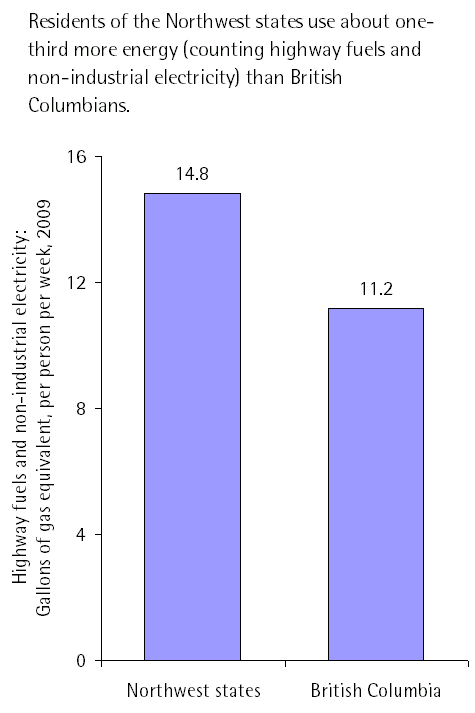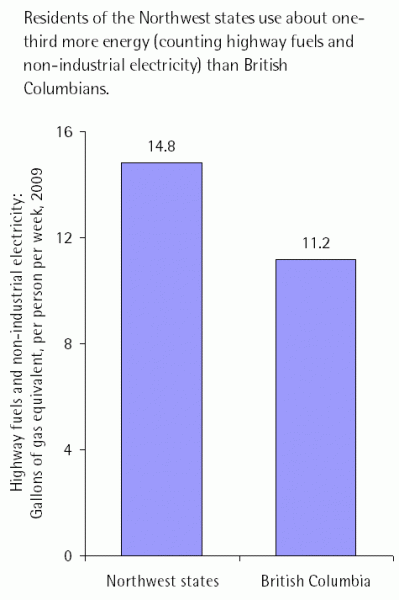On average, Cascadians burn 9 gallons of gasoline and diesel each week, and use enough electricity in homes and businesses to keep ten 100-watt light bulbs burning continuously (with an extra 25-watt compact fluorescent thrown in for good measure). All told, the typical Northwest resident consumes the energy-equivalent of just over two gallons of gasoline every single day.
That’s nearly double the energy consumption of more energy-efficient industrialized nations such as Germany, Great Britain, and Japan–nations that enjoy high standards of living despite consuming far less energy per person than northwesterners do. Germany in particular has aggressively pursued efficiency and renewable energy policies over the past decade; and while the nation still emits far more than its share of global-warming emissions from fossil fuels, it nevertheless stands as a developed-world model that Cascadia can aspire to match.
Fossil fuel consumption lies at the root of many of our region’s most serious problems. Each barrel of oil we burn for highway fuels adds nearly half a ton of climate-warming gases to the atmosphere; releases perhaps 60 pounds of carbon monoxide, soot, and smog-forming compounds that endanger our health; siphons between $40 and $140 out of the local economy; increases the risk of oil spills and pipeline leaks; and entangles our region with some of the most volatile and politically unstable regimes in the world. Cascadians consume more than 300 million barrels of oil each year. Coal and natural gas also carry steep costs, both financial and environmental. Even hydropower dams, though comparatively benign in their climate impacts, cut salmon off from vast areas of spawning habitat.
We pay a steep price for this energy. Twice in the past decade, when oil prices have spiked, fossil fuel spending from the Northwest states has topped $30 billion in a single year. [Update!] (Click for chart of Northwest fossil fuel spending through 2009.) High energy prices, coupled with economic jitters, have dampened the Northwest’s appetite for energy in recent years. Still, Cascadians are profligate energy consumers, and the region’s energy use has been stuck in high gear for decades. But that overall stasis conceals three diverging trends. After spiking in the late 1970s, per person gasoline consumption maintained a rough equilibrium from the mid 1980s through 1999.
But then, per capita gasoline consumption began to fall—first gradually and then more rapidly. (Click for chart of Northwest gasoline consumption.) Diesel fuel use, on the other hand, had been on a long-term upswing, interrupted only in the last two years. And per capita electricity use in Cascadia’s homes and businesses has wavered only a bit since 1980.
Falling gas consumption in recent years demonstrates an age-old truth: when something gets more expensive, we use less of it. And northwesterners’ sensitivity to gas prices does point to a way forward to end the region’s unhealthy addiction to oil. As expensive as a gallon of gasoline may seem, the price at the pump fails to cover the costs of global warming, air pollution, petroleum-related military spending–or even the costs of streets and roads. Ensuring that all consumers pay the full cost of their energy purchases–rather than pushing those costs onto their neighbors or their grandchildren–can create the financial incentives that are needed to wean our region from its unhealthy dependence on fossil fuels. A carbon cap-and-trade system, or a carbon tax on fossil fuels (modeled, perhaps, on British Columbia’s existing carbon tax shift), would help recapture some of the economic and environmental damage caused by fossil fuel consumption, while encouraging a smooth transition to cleaner and more stable energy sources.











